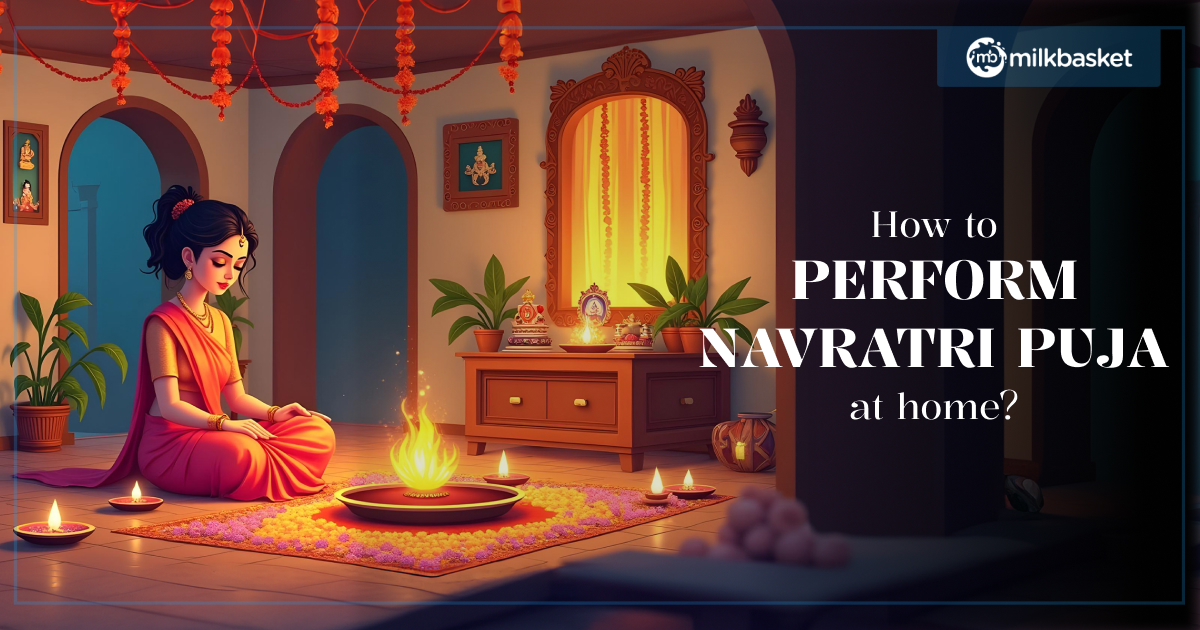

Navratri is a deeply spiritual festival that celebrates the power and grace of Goddess Durga over nine nights. It’s a time when we fill our homes with joy, prayer, and the spirit of renewal. Conducting the Navratri puja at home brings us closer to divine energy, uniting family and friends in a beautiful ritual of devotion and celebration.
Let’s prepare to welcome blessings and positive energy into our lives with each day of this sacred festival.
Here’s a comprehensive list of things you’ll need for the Navratri Puja:
The first step in your Navratri Pooja is setting up the space. Begin by placing the idol of Maa Durga on a chowki (a small platform).
Nearby, set a clay pot (ghata) filled with soaked barley seeds. This Ghata Sthapana symbolically marks the beginning of your puja and signifies the presence of auspicious energy.
Next, establish the Kalash, which is a sacred pot representing abundance. Pour holy water (Gangajal) into the pot and adorn it with fresh flowers, mango leaves, and coins.
After placing the lid securely on the Kalash, cover the top with raw rice and place a coconut wrapped in red cloth (roli) on top. This sacred setup signifies prosperity and is an essential element in the Navratri rituals.
With the setup complete, proceed to worship Goddess Durga. Begin by lighting an oil lamp (diya) in front of the deity’s idol.
Use the Panchopchar method of worship, which means offering five items: a fragrant scent, flowers, a diya, an incense stick, and Naivedya (food offerings like sweets or fruits).
These offerings demonstrate your devotion and invite the goddess’s blessings into your space.
This step involves invoking the goddess through the chowki. Spread a little roli on the chowki, and tie a moli (sacred red thread) around it.
Place the idol of Goddess Durga atop the chowki, representing her presence in your home. This personal connection allows devotees to feel the energy of the goddess more closely.
During the nine days of Navratri, chanting prayers and invoking the blessings of Durga Maa is considered auspicious.
s you continue with the Navratri Puja, offer fresh flowers, bhog (food offerings), diya, and fruits. Each day can feature different rituals and prayers, intended to invite positivity and well-being into the lives of your family members.
As part of the ritual, prepare for the Aarti, a ceremonial light offering to the deity. Decorate a thali (plate) with items used for the Aarti, such as diya, flowers, and incense. Hold the thali in one hand and a bell in the other.
Sing the traditional Aarti song while jingling the bells, seeking blessings from Maa Durga. This moment is filled with joy and devotion, enhancing the family’s spiritual connection.
On the last (ninth) day of Navratri, it’s time for Kanya Puja or Kanchika Puja, a beautiful ritual where you invite nine girls, symbolizing the nine manifestations of Goddess Durga.
These girls, typically aged between 5 and 12, are considered goddesses themselves. Prepare meals and offer them hospitality, reflecting your gratitude and respect.
This act of service is believed to bring peace and blessings to your household.
As you stock up on all your Navratri essentials with Milkbasket, you’re not just preparing for a festival; you’re setting the stage for a sacred tradition that reverberates with cultural heritage and divine worship.
Milkbasket makes it effortless to gather everything you need, ensuring that you can focus on the spirit of the celebration.
Remember, Navratri is a time of reflection, devotion, and celebration of the divine feminine power within us all.
Let Milkbasket, an online grocery app help you honor these nine auspicious nights with devotion and joy, making this Navratri memorable and spiritually fulfilling. Just download the app, add your items to the cart, and get them silently delivered to your doorstep by 7 AM.
It’s time to bring devi to your home and celebrate the 9 days with joy and devotion 🌸
Ah, summer! In other words, get ready to explore different types of mangoes that make…
When summer hits hard, and the mercury rises, there's nothing more refreshing than a cool,…
When summer’s in full swing and the sun is on a mission to roast everything…
Baisakhi, the vibrant harvest festival celebrated primarily in the Punjab region of India, marks the…
Pistachios are more than just a tasty snack. They’re a powerhouse of nutrients and a…
Summer is here, and with it comes the inevitable heat. While reaching for sugary drinks…